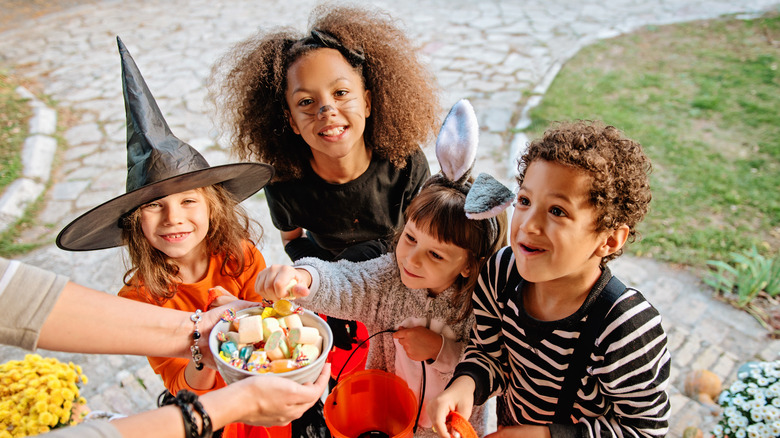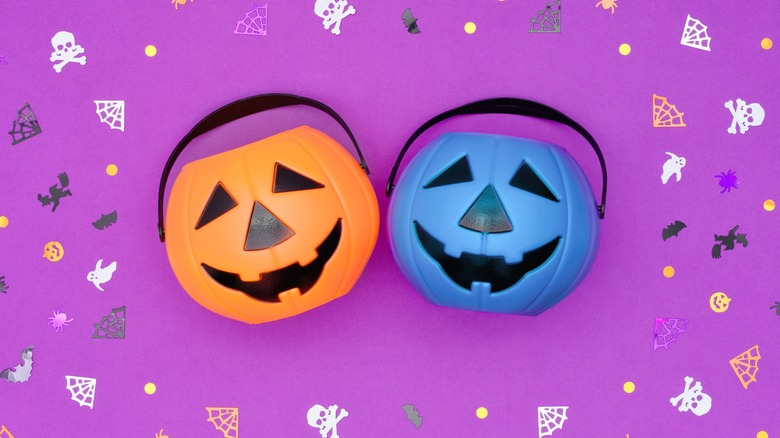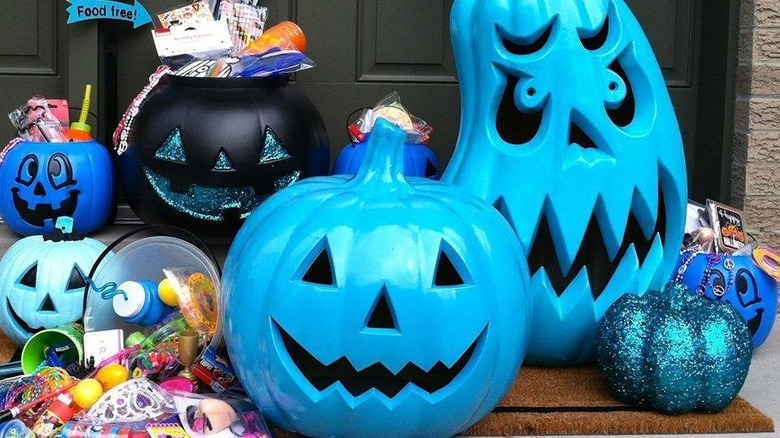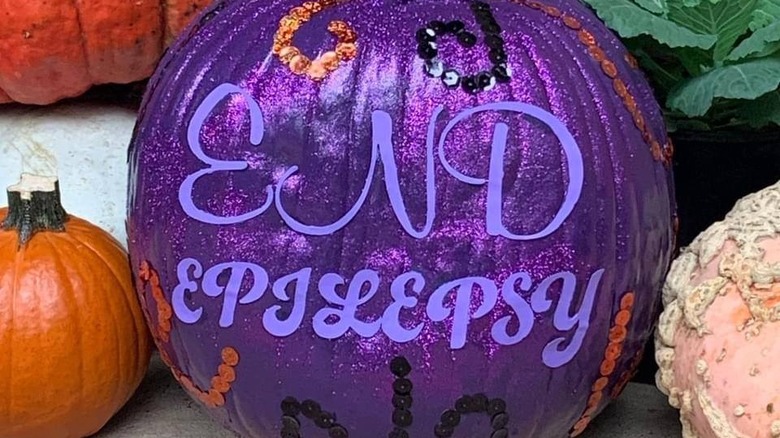The Pumpkin Color Meanings You Should Know For Trick-Or-Treating
The origins of Halloween are rooted in the Celtic harvest festival Samhain, which included bonfire lighting and wearing costumes to fend off spirits (via Library of Congress). The Catholic All Saints' Day on November 1 began in the 8th century, and eventually, the Pagan and Christian rituals commingled and turned into our Halloween.
National Geographic explains that while trick-or-treating has roots in these ancient traditions, the modern-day version in the U.S. took off after World War II when sugar rations had ended. The rise of suburban neighborhoods meant kids could go door-to-door safely at night, and by the 1950s, commercialization of the holiday was underway, with pre-wrapped candy easier to hand out to hordes of kids than homemade treats.
While trick or treating seems like a holiday tailor-made for all kids, Click on Detroit reminds us not all children have a positive reaction to candy and costumes. So, different colored pumpkins offer alerts to both parents and neighbors to help ensure all the district's kiddos have a great — and safe — night out.
Blue pumpkins
Blue pumpkins were first put out to raise awareness for autism, according to Good Housekeeping, which cites a Louisiana home first going viral for their blue patch in 2018. While the blue pumpkins are a great way to bring awareness — and start conversations — about autism, adults on door duty should be on the lookout for kids carrying blue trick-or-treat buckets since they could be on the spectrum.
The child may be non-verbal, so don't try to force a trick-or-treat-out of them. Or, they could have sensory overload by loud displays or wild costumes. A blue pumpkin placed outside your home will signal to the guardians of kids on the spectrum that you've prepared your house to minimize any triggers, a welcome sight to caregivers who want their kids to experience the holiday like any other, but safely.
It's worth noting some parents have pushed back the on the blue pumpkin. According to a report on News 5 Cleveland, some aren't keen on having a visual cue that signals a child on the spectrum. So, adults handing out treats should simply be prepared to adjust to each child's individual response.
Teal pumpkins
According to Food Allergy Research and Education (FARE), one in 13 kids lives with a food allergy. The Teal Pumpkin Project, which a local Tennessee food group launched in 2012 before it was expanded nationally via FARE, raises awareness about food allergies with the goal of making Halloween safer and inclusive for children living with them.
Kids carrying teal buckets signify they have some sort of food allergy or sensitivity, so if you have allergen-free treats on hand — think non-food items like vampire teeth or stickers — drop those into the teal buckets. Likewise, seeing a teal pumpkin on a lawn or stoop signals to caregivers of allergy kids that the home offers safe trinkets instead of food.
According to the Northeast Allergy, peanuts are the most common trigger of lethal food reactions. Given that Reese's Peanut Butter Cups reign supreme on Halloween, knowing what the teal pumpkins mean may keep a child out of the ER on that night.
Purple pumpkins
According to Good Housekeeping, the Epilepsy Foundation began the Purple Pumpkin Project in 2012 to bring awareness to childhood epilepsy and to raise funds for ongoing research. Over the pandemic, however, the purple pumpkins took on new meaning. Homes that displayed purple pumpkins signified that the homeowner was taking additional COVID-19 precautions, like donning masks when answering the door and offering wrapped candy in grab-and-go bags. Given we are not yet out of the pandemic woods, those exercising caution should keep an eye out for homes carrying pumpkins with the purple hue.
Making Halloween inclusive for all kids is a nice thing to do. According to Berkeley's Greater Good Magazine, all humans benefit from Halloween traditions. Whether it's the serotonin boost from the chocolate (adults, feel free to add wine), the healthy cortisol release extracted by jump scares, or simply the act of ritual that brings communities together, the holiday is a boon to mental health.



